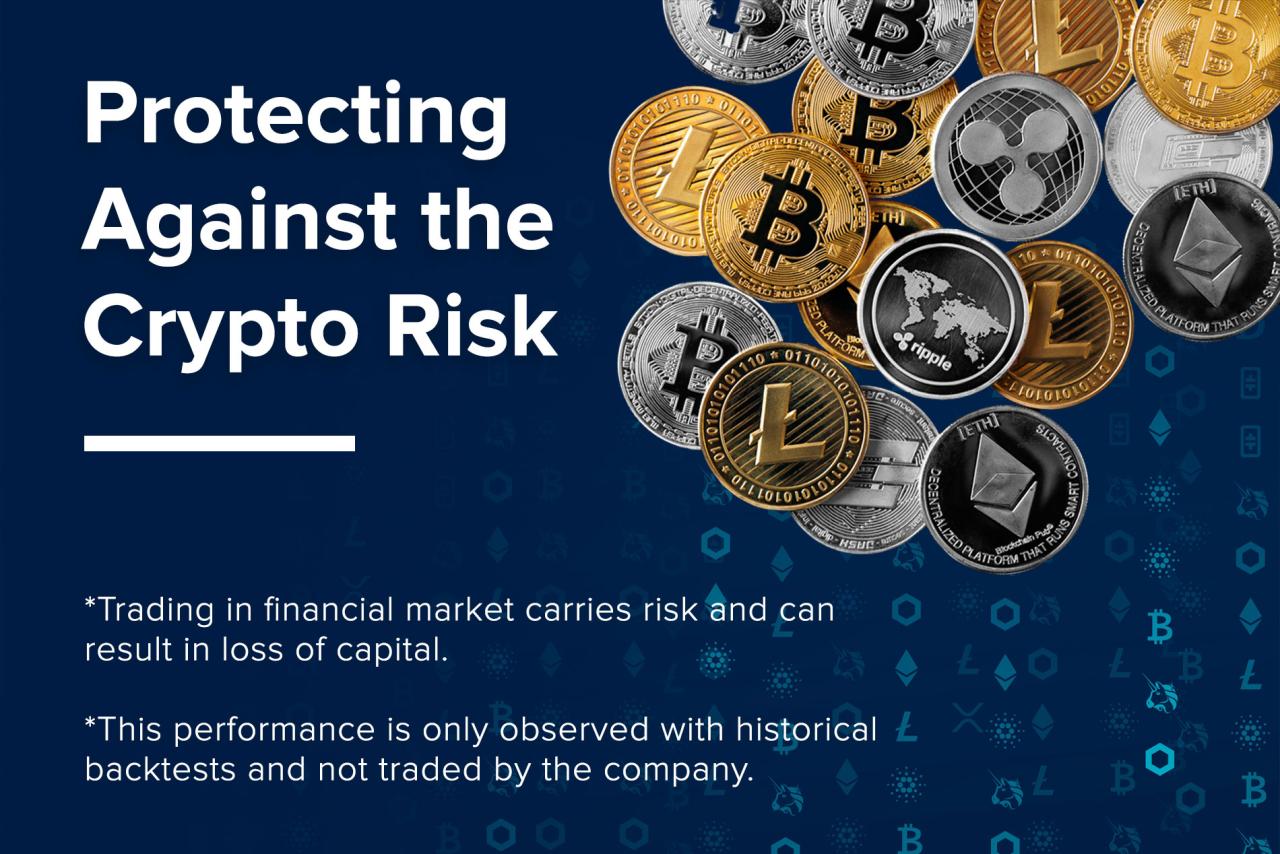
The Biggest Crypto Security Risks & How to Protect Yourself
The Biggest Security Risks in Crypto and How to Avoid Them is a crucial topic in today’s digital landscape. Cryptocurrencies have exploded in popularity, but with this rise comes a heightened need for understanding and mitigating security risks. From exchange vulnerabilities to social engineering tactics, this post explores the threats facing crypto investors and provides actionable steps to safeguard your digital assets.
We’ll delve into the specific security challenges associated with various crypto platforms, including exchanges, wallets, and smart contracts. We’ll examine the common methods hackers use to exploit these systems, and offer practical advice for users to protect their investments. We’ll also cover emerging threats and regulatory considerations, providing a comprehensive guide to navigating the complexities of crypto security.
Introduction to Crypto Security Risks
The cryptocurrency market has exploded in recent years, attracting millions of users and investors. This rapid growth, while exciting, has also highlighted the critical need for robust security measures. Protecting digital assets from theft and fraud is paramount, and understanding the inherent risks is crucial for anyone involved in the cryptocurrency ecosystem. The potential for financial loss, reputational damage, and even legal repercussions underscores the importance of proactive security strategies.Understanding and mitigating these risks is essential for both individual users and institutional investors.
Losses due to hacks, scams, and vulnerabilities can be substantial, affecting personal finances and potentially disrupting the broader financial system. Furthermore, a lack of security can erode public trust in the cryptocurrency space, hindering its continued adoption and development.
Notable Crypto Security Breaches and Their Impacts
The history of cryptocurrency is punctuated by significant security breaches. These incidents, ranging from simple phishing scams to sophisticated exploits, have highlighted vulnerabilities in various aspects of the ecosystem. The Mt. Gox exchange collapse in 2014, resulting in billions of dollars in losses, served as a stark reminder of the risks associated with centralized platforms. More recently, numerous hacks targeting smaller exchanges and DeFi protocols have underscored the ongoing need for robust security measures.
These events, often involving sophisticated attacks and exploiting vulnerabilities in smart contracts, underscore the critical need for continuous security audits and proactive threat detection.
Comparison of Crypto Asset Security Vulnerabilities
Understanding the inherent security risks varies significantly depending on the type of cryptocurrency asset. The table below compares Bitcoin, Ethereum, and stablecoins, highlighting their typical vulnerabilities.
| Crypto Asset | Typical Security Vulnerabilities |
|---|---|
| Bitcoin | While Bitcoin’s decentralized nature makes it resistant to single points of failure, it is susceptible to large-scale hacks, especially during periods of high volatility, and issues associated with its network infrastructure. The inherent security of Bitcoin’s network is based on the consensus mechanism and the distributed ledger. However, security breaches in the broader crypto space can impact Bitcoin’s value. |
| Ethereum | Ethereum’s smart contracts, while enabling innovative applications, are prone to vulnerabilities, potentially leading to exploits. The complexity of smart contracts can obscure logical errors and weaknesses, which malicious actors can exploit to execute fraudulent transactions or steal funds. The vast number of decentralized applications (dApps) built on the Ethereum blockchain adds another layer of complexity and risk. |
| Stablecoins | Stablecoins, designed to maintain a stable value peg to fiat currencies, are susceptible to manipulation and algorithmic failures. The underlying collateral or mechanisms maintaining the peg can be compromised, leading to substantial value fluctuations and losses. This instability can undermine investor confidence and the stability of the broader crypto market. The reliance on external factors (like the value of the pegged currency) can introduce vulnerability. |
Exchange Security Risks

Source: cloudfront.net
Cryptocurrency exchanges, while convenient, are susceptible to various security threats. These platforms act as intermediaries between buyers and sellers, holding significant amounts of digital assets. Consequently, they become prime targets for malicious actors seeking to exploit vulnerabilities and steal cryptocurrencies. Understanding these risks is crucial for investors to make informed decisions and mitigate potential losses.
Common Security Threats Targeting Exchanges
Cryptocurrency exchanges face a multitude of threats, including hacking, phishing, and insider trading. Hackers often target vulnerabilities in exchange systems to gain unauthorized access to user accounts and funds. Phishing attacks aim to trick users into revealing their login credentials or personal information, enabling attackers to gain access to their accounts. Insider threats, involving malicious actors within the exchange itself, pose a significant risk to the platform’s security and user funds.
Furthermore, the increasing complexity of blockchain technology and the potential for manipulation or fraud contribute to the overall security landscape for exchanges.
Methods Used by Hackers to Compromise Exchange Platforms
Hackers employ various sophisticated methods to compromise exchange platforms. These methods include exploiting vulnerabilities in software, employing social engineering tactics to manipulate users, and launching distributed denial-of-service (DDoS) attacks to overwhelm exchange systems. Advanced persistent threats (APTs) are another significant concern, involving highly skilled hackers who meticulously target specific exchanges to steal large sums of cryptocurrencies. The constant evolution of these techniques necessitates a dynamic approach to security by exchange platforms.
Vulnerabilities Commonly Leading to Theft
Several vulnerabilities commonly lead to theft from cryptocurrency exchanges. These include insufficient security protocols, inadequate staff training, and a lack of robust security measures. Outdated software and weak encryption can create entry points for hackers. Poorly secured APIs and inadequate monitoring systems can leave exchanges vulnerable to unauthorized access and manipulation. These vulnerabilities highlight the need for proactive security measures to protect against sophisticated attacks.
Exchange Security Measures and Effectiveness
| Security Measure | Description | Effectiveness |
|---|---|---|
| Multi-factor Authentication (MFA) | Adds an extra layer of security beyond usernames and passwords. | High. Significantly reduces unauthorized access. |
| Cold Storage | Storing a portion of the cryptocurrency offline, reducing the risk of online theft. | High. Offline storage mitigates direct hacking risks. |
| Firewall Protection | Blocking unauthorized network access. | Medium. Effective against basic attacks but may not stop advanced threats. |
| Regular Security Audits | Periodic reviews of the platform’s security posture. | High. Identifies vulnerabilities and weaknesses. |
| Secure Hardware (e.g., TPMs) | Using specialized hardware to enhance security. | High. Adds an extra layer of protection against sophisticated attacks. |
Steps Investors Can Take to Protect Themselves
Investors can take several steps to protect themselves when using cryptocurrency exchanges. First, use strong, unique passwords for each account and enable multi-factor authentication (MFA). Be cautious of suspicious emails or messages, and never share personal information or login credentials with anyone. Regularly monitor account activity and promptly report any suspicious transactions. Choosing reputable exchanges with established security protocols is crucial.
Finally, keep up-to-date with the latest security best practices for cryptocurrency investments. Understanding the threats and taking proactive steps is essential for safeguarding digital assets.
Wallet Security Risks
Protecting your crypto assets starts with securing your wallets. A compromised wallet can lead to significant financial losses, and understanding the risks associated with different wallet types is crucial. This section delves into the vulnerabilities of various crypto wallets, from hot wallets to hardware wallets, and explores the best practices for safeguarding your digital assets.Hot wallets, while convenient, often pose greater security risks due to their online nature.
Cold wallets, on the other hand, are offline, offering increased protection. However, each type presents unique challenges. Hardware wallets, a middle ground, provide a robust layer of security, but they come with their own set of considerations. We’ll explore these intricacies in detail.
Types of Crypto Wallets and Their Security Risks
Different crypto wallets cater to diverse needs, but each carries unique security implications. Understanding these distinctions is key to selecting the appropriate wallet for your needs and minimizing potential threats.
- Hot Wallets: These wallets are connected to the internet, allowing for quick transactions. Their accessibility makes them convenient, but this online connection exposes them to a broader range of cyber threats, including phishing scams, malware infections, and man-in-the-middle attacks. Regular updates and robust security measures are essential for hot wallets to mitigate these risks.
- Cold Wallets: These wallets operate offline, reducing their vulnerability to online attacks. They are often used for storing significant amounts of cryptocurrency, providing a safer environment compared to hot wallets. However, physical security of the cold wallet device remains critical. Loss or theft of the device containing the private keys poses a major risk.
- Hardware Wallets: These physical devices are specifically designed for secure cryptocurrency storage. They provide a robust layer of security by separating the private keys from the internet. Hardware wallets generally offer strong encryption and secure storage mechanisms. While hardware wallets are generally considered secure, physical protection and adhering to manufacturer recommendations are still crucial.
Common Attacks Targeting Crypto Wallets
Various malicious actors employ various strategies to compromise crypto wallets. Understanding these tactics is crucial for developing robust defense mechanisms.
- Phishing: Sophisticated phishing attacks often target users with convincing fake websites or emails. These scams trick users into revealing their private keys or login credentials, leading to significant losses. Maintaining vigilance and verifying the legitimacy of websites and emails is critical.
- Malware: Malware infections can compromise a device, stealing private keys or enabling unauthorized access to wallets. Regular security software updates and cautious downloads are essential.
- Social Engineering: Social engineering exploits human psychology to manipulate individuals into divulging sensitive information. Criminals often impersonate trusted entities or leverage psychological pressure to gain access to wallets.
Comparing and Contrasting Wallet Security Features
Choosing the right wallet depends on the level of security needed and the trade-offs between convenience and protection.
| Wallet Type | Security Features | Pros | Cons |
|---|---|---|---|
| Hot Wallets | Easy access, wide platform compatibility | Convenience, speed of transactions | Vulnerable to online threats, requires constant vigilance |
| Cold Wallets | Offline operation, reduced online vulnerability | Higher security compared to hot wallets | Less convenient, potentially complex setup |
| Hardware Wallets | Strong encryption, physical separation of keys | Robust security, offline operation | Can be more expensive, setup process might require more technical knowledge |
Importance of Strong Passwords and Robust Security Measures
Robust security practices are vital for protecting your crypto assets. Strong passwords, combined with two-factor authentication (2FA), significantly reduce the risk of unauthorized access.
Using strong, unique passwords for each wallet and enabling 2FA enhances security. Avoid using easily guessable passwords or reusing passwords from other accounts.
Smart Contract Security Risks

Source: identitymanagementinstitute.org
Smart contracts, while offering potential for automation and trustlessness, are susceptible to various security vulnerabilities. These vulnerabilities can lead to significant financial losses and reputational damage for both developers and users. Understanding these risks is crucial for building and deploying secure smart contracts.Smart contracts, designed to execute predefined agreements automatically, often operate within complex environments. The inherent complexity of these agreements and the need for robust security mechanisms to prevent exploitation are significant concerns.
Navigating the crypto world involves serious security considerations. Protecting your digital assets is paramount, and understanding the pitfalls is crucial. Fortunately, innovative solutions like crypto staking, as detailed in this insightful piece on Why Crypto Staking Could Be the Future of Passive Investing , might offer a secure path to passive income. However, even with these promising developments, users still need to be vigilant about phishing scams, weak passwords, and the importance of robust security measures to safeguard their investments.
Failure to address these vulnerabilities can lead to devastating consequences, impacting not only the immediate parties involved but potentially the entire ecosystem.
Security Vulnerabilities in Smart Contracts
Smart contracts are vulnerable to various security flaws that can be exploited by malicious actors. These flaws often arise from issues with the underlying code, design choices, or interactions with external systems. Understanding these vulnerabilities is essential for developing robust smart contract solutions.
- Reentrancy Attacks: Reentrancy vulnerabilities allow attackers to repeatedly call a smart contract function, potentially draining funds or manipulating the contract’s state. This occurs when a contract calls another contract, and the called contract unexpectedly modifies the state of the calling contract before it returns. The critical aspect is that the calling contract might not have enough time to prevent the repeated calls.
This vulnerability is often associated with improper design and state management within smart contracts. An example would be an attack where an attacker’s contract is called by the target contract; the attacker then uses this opportunity to repeatedly call the target contract, ultimately draining the target contract’s funds.
- Arithmetic Overflow/Underflow: Smart contracts frequently use arithmetic operations. Errors in these operations, such as integer overflow or underflow, can lead to incorrect calculations, allowing attackers to manipulate the contract’s logic and extract funds or gain unauthorized access. This vulnerability can arise from assumptions about the range of values involved in calculations and can have profound impacts on contract stability. An example is a contract that calculates a reward based on a variable; if the variable goes beyond the maximum value that the system can handle, an overflow can occur, resulting in an unexpected result.
- Time-Based Attacks: These exploits leverage timing differences or vulnerabilities in the way a smart contract handles time-dependent operations. Attackers can manipulate the timing of transactions to exploit vulnerabilities in the contract’s logic. This could involve a race condition where a malicious actor exploits a small window of opportunity to manipulate the outcome of a transaction.
Importance of Auditing and Testing
Thorough auditing and testing are critical for identifying and mitigating security vulnerabilities in smart contracts. These procedures can significantly reduce the risk of exploits and ensure the contract’s functionality and safety.
- Formal Verification: Employing formal verification techniques can provide a rigorous and systematic approach to checking the correctness and security of smart contracts. This involves using mathematical methods to verify the contract’s behavior and identify potential flaws. This method can prove or disprove the validity of certain aspects of the contract’s code.
- Penetration Testing: Conducting penetration testing, simulating attacks on the contract, can reveal vulnerabilities that might not be apparent through static analysis. This can identify vulnerabilities that are not easily detectable through manual code reviews or automated tools. This is crucial to ensure that the contract can withstand real-world attack attempts.
- Manual Code Review: A careful examination of the contract’s code by experienced developers can highlight potential issues and weaknesses that automated tools might miss. This can identify logic errors, unexpected interactions, or areas that require improvement. This method is particularly valuable for contracts that have complex logic or interactions with external systems.
Critical Aspects of Smart Contract Security
Several critical aspects require immediate attention when designing and deploying smart contracts. These are vital to minimizing security risks and enhancing the overall reliability of the contract.
- Input Validation: Implementing robust input validation to prevent malicious input from affecting the contract’s execution. This includes checking the validity of user-provided data to prevent attacks based on manipulating input values.
- State Management: Employing clear and secure methods to manage the state of the contract, especially when interacting with external systems or other contracts. A clear and comprehensive approach to contract state management is essential to ensure data integrity and prevent unintended behavior.
Smart Contract Complexity and Vulnerability Risk
The complexity of a smart contract directly correlates with the risk of vulnerabilities. More complex contracts have a higher chance of containing hidden flaws.
| Smart Contract Complexity | Risk of Vulnerabilities |
|---|---|
| Low | Low |
| Medium | Medium |
| High | High |
Social Engineering and Phishing Attacks: The Biggest Security Risks In Crypto And How To Avoid Them
Social engineering, a deceptive practice that preys on human psychology, poses a significant threat to cryptocurrency users. Criminals exploit trust and vulnerabilities to manipulate individuals into revealing sensitive information like passwords, private keys, or revealing their crypto assets. Phishing, a specific form of social engineering, targets victims with fraudulent communications designed to trick them into providing personal data.
In the cryptocurrency realm, these attacks are particularly damaging due to the high value of digital assets.
Common Social Engineering Tactics
Social engineering tactics leverage psychological manipulation to trick users. These techniques range from seemingly innocuous messages to elaborate schemes. These include impersonation of trusted figures, creating a sense of urgency, exploiting fear, or leveraging authority. Criminals may also use social engineering to gain access to personal information or manipulate users into divulging sensitive details.
Protecting your crypto is crucial, and understanding the biggest security risks is key. Phishing scams and weak passwords are major threats. However, staking crypto for long-term gains introduces a unique set of risks, too. Learning how to mitigate those risks is essential, like checking the reputation of the staking platform before you commit your crypto. Check out this helpful guide on How to Reduce Risks When Staking Crypto for Long-Term Gains to bolster your knowledge on secure staking practices.
Ultimately, staying informed and vigilant about these threats is vital to safeguarding your crypto investments.
Phishing in Compromising User Accounts and Wallets
Phishing attacks are a common method for compromising user accounts and wallets. Phishing emails, SMS messages, or even malicious websites often mimic legitimate platforms, like cryptocurrency exchanges or wallet providers. These deceptive communications attempt to trick users into providing login credentials, private keys, or other sensitive information, enabling attackers to gain access to their accounts.
Types of Phishing Attempts in the Crypto Space
Various phishing attempts target cryptocurrency users. Common types include:
- Fake Exchange Notifications: These phishing attempts often imitate official notifications from cryptocurrency exchanges, prompting users to click on links to update account details or verify their identities. These links often lead to fraudulent websites that mimic the legitimate exchange, allowing attackers to capture login credentials.
- Fake Wallet Support: Attackers might impersonate customer support from cryptocurrency wallets. They may contact users with fabricated support issues, urging them to reveal their private keys or enter their wallet passwords to resolve the problem. The objective is to gain unauthorized access to users’ digital assets.
- Phishing Links in Social Media: Social media platforms are often exploited to spread phishing links disguised as legitimate promotions or giveaways. Users might be enticed by offers of free crypto or large rewards, clicking on links that lead them to fraudulent websites.
- Fake Investment Opportunities: Criminals may craft elaborate schemes promising high returns on cryptocurrency investments. They may lure victims into joining fraudulent investment platforms or providing their assets to fake managers.
Best Practices to Avoid Social Engineering Attacks
Maintaining a secure approach to crypto is crucial. Following best practices can significantly reduce the risk of falling victim to social engineering attacks.
Protecting your crypto is crucial, and understanding the biggest security risks is key. Things like phishing scams and weak passwords are common threats. To really nail down how to navigate these issues, checking out Essential Risk Management Techniques for Successful Cryptocurrency Trading Today provides a solid framework for good risk management. This approach helps you avoid pitfalls, whether it’s setting strong security protocols or diversifying your holdings.
Ultimately, a layered approach to security is the best defense against the biggest crypto risks.
- Verify the Source: Before clicking any links or providing any information, carefully verify the source. Contact the official platform directly to confirm the legitimacy of the request. Avoid clicking on links in unsolicited emails or messages.
- Beware of Urgent Requests: Be cautious of messages creating a sense of urgency. Legitimate platforms typically do not demand immediate action or threat of losing access.
- Use Strong Passwords: Employ strong, unique passwords for each cryptocurrency account and wallet. Consider using a password manager to help keep track of these complex passwords.
- Enable Two-Factor Authentication (2FA): Activating 2FA adds an extra layer of security to your accounts. This prevents unauthorized access even if an attacker obtains your password.
- Educate Yourself: Stay informed about common social engineering tactics and phishing attempts. Recognizing these techniques can help you avoid falling victim to fraudulent schemes.
Examples of Phishing Emails and SMS Messages, The Biggest Security Risks in Crypto and How to Avoid Them
The following table presents examples of common phishing emails and SMS messages targeting crypto users:
| Type | Example | Description |
|---|---|---|
| Phishing Email (Fake Exchange) | Subject: Urgent Account Verification Required | Mimics a legitimate exchange notification, requesting users to verify their account information by clicking on a malicious link. |
| Phishing SMS (Fake Wallet Support) | Message: Your wallet needs immediate attention. Click here to resolve the issue. | Impersonates wallet support, urging users to click on a link that leads to a fraudulent website. |
| Phishing Email (Fake Investment Opportunity) | Subject: Unbelievable Crypto Investment Opportunity | Promotes a high-return investment opportunity, leading to a fraudulent platform. |
| Phishing SMS (Fake Giveaway) | Message: Win free Bitcoin! Click this link for details. | Promotes a giveaway or contest, using a malicious link to steal personal information. |
Security Measures and Best Practices
Protecting your crypto assets requires a multi-layered approach. Simply choosing a secure platform isn’t enough; proactive measures are crucial. This section details essential strategies for safeguarding your digital wealth, from employing robust authentication methods to adopting secure storage solutions.Effective security hinges on understanding and implementing best practices, tailored to the specific risks involved. This includes recognizing the importance of strong passwords, regular updates, and avoiding suspicious activities.
By diligently applying these measures, you can significantly mitigate the likelihood of compromise and maintain control over your crypto holdings.
Multi-Factor Authentication (MFA) and Two-Factor Authentication (2FA)
Implementing MFA and 2FA is paramount for enhanced account security. These methods add an extra layer of protection, requiring verification beyond a simple password. This prevents unauthorized access even if a password is compromised. By combining a password with a one-time code or biometric verification, you create a formidable barrier against attackers.
Cold Storage
Cold storage, or offline storage, is a crucial element in crypto security. Storing your cryptocurrencies offline, separate from internet-connected devices, minimizes the risk of hacking and malware. This method isolates your private keys, rendering them inaccessible to online threats. Hardware wallets, which are a type of cold storage, are a popular option for safeguarding crypto assets. A hardware wallet is a physical device that stores your private keys offline, protecting them from online threats and malware.
Regular Software and Security Protocol Updates
Regularly updating your software and security protocols is vital for maintaining a strong security posture. Software updates often include critical security patches that address vulnerabilities. Failing to update your software can leave your system exposed to exploits and malware, increasing the risk of unauthorized access.
Secure Crypto Practices Recommendations
- Strong Passwords: Use a unique, complex password for each crypto account. Avoid easily guessable passwords, and consider using a password manager to securely store and generate strong passwords.
- Avoid Phishing Attempts: Be cautious of unsolicited emails, messages, or websites asking for your login credentials. Verify the authenticity of any requests before providing personal information.
- Regular Security Audits: Periodically review your accounts for suspicious activity. Monitor your transactions and watch for any unusual patterns that could indicate a security breach.
- Enable MFA/2FA: Wherever possible, activate MFA or 2FA for all your crypto accounts. This adds an extra layer of protection, requiring verification beyond a simple password.
- Secure Your Devices: Use strong passwords and security software on all devices used to access crypto accounts.
- Use a Reputable Exchange/Wallet: Choose reputable platforms with strong security measures to minimize the risk of theft or fraud.
- Be Aware of Social Engineering: Be cautious of individuals or groups who attempt to manipulate you into revealing personal information or accessing your accounts. Be skeptical of unsolicited requests for sensitive data.
- Educate Yourself: Stay informed about the latest security threats and best practices in the cryptocurrency world. Continuously learning about the latest security risks will help you stay ahead of the curve.
Regulatory and Legal Risks
The cryptocurrency landscape is constantly evolving, with governments worldwide grappling with how to regulate this burgeoning asset class. This dynamic environment presents significant legal and regulatory risks for investors and businesses operating in the crypto space. Navigating these complexities is crucial for mitigating potential financial and legal repercussions.The rapidly changing regulatory framework surrounding cryptocurrencies significantly impacts investment security.
Uncertainty about legal interpretations and enforcement procedures can lead to market volatility and potentially substantial losses for investors. Furthermore, differing regulations across jurisdictions create challenges for businesses seeking to operate internationally and for individuals looking to invest in cryptocurrencies globally.
Evolving Regulatory Landscape
The regulatory landscape surrounding cryptocurrencies is characterized by a patchwork of approaches worldwide. Some jurisdictions have embraced cryptocurrencies with clear regulatory frameworks, while others remain hesitant, or even outright hostile. This inconsistency creates a complex environment for businesses and investors operating internationally.
Impact of Regulatory Changes on Crypto Investments
Regulatory changes can dramatically affect the value and liquidity of crypto assets. For example, a sudden ban on certain cryptocurrencies in a major market could trigger a significant price drop, impacting investors holding those assets. Furthermore, regulatory uncertainty can deter institutional investors from entering the market, reducing overall market liquidity.
Legal Implications of Crypto Activities
Engaging in crypto activities often involves legal implications related to taxation, money laundering, and sanctions. Misunderstanding or failing to comply with these regulations can lead to severe penalties, including fines and criminal charges. Tax implications vary significantly depending on the jurisdiction and the nature of the crypto activity.
Examples of Countries with Varying Regulations
Different countries have adopted diverse approaches to regulating cryptocurrencies. For instance, some countries have issued licenses for crypto exchanges, while others have imposed stricter controls on cryptocurrency transactions. China’s complete ban on cryptocurrency trading exemplifies one extreme approach, while Switzerland’s supportive regulatory framework showcases another. The differing regulatory landscapes in these and other countries highlight the need for investors and businesses to carefully assess the legal and regulatory environment in each jurisdiction before engaging in any crypto activities.
Legal and Regulatory Risks Related to Different Crypto Activities
| Crypto Activity | Potential Legal and Regulatory Risks |
|---|---|
| Crypto Exchange Operations | Licensing requirements, Know Your Customer (KYC) regulations, Anti-Money Laundering (AML) compliance, transaction reporting requirements. |
| Cryptocurrency Trading | Tax implications (capital gains, income tax), market manipulation regulations, regulatory scrutiny of trading platforms. |
| Cryptocurrency Mining | Environmental regulations, energy consumption limits, licensing requirements, taxation of mining profits. |
| Cryptocurrency Investment Funds | Investment regulations, fund structuring compliance, investor protection regulations, transparency requirements. |
Emerging Threats and Future Trends
The crypto landscape is in constant flux, with new technologies and applications emerging rapidly. This dynamism brings exciting opportunities but also introduces novel security challenges. Understanding these emerging threats and anticipating their potential impact is crucial for safeguarding crypto investments and fostering the continued growth of the industry.The evolution of crypto technologies, including decentralized finance (DeFi), non-fungible tokens (NFTs), and the metaverse, introduces new avenues for both innovation and exploitation.
Security vulnerabilities in these emerging applications often stem from a lack of established security protocols and the complexity of interacting systems.
Emerging Vulnerabilities in Decentralized Finance (DeFi)
The DeFi ecosystem, with its automated protocols and decentralized nature, presents a unique set of security challenges. Exploits like flash loans, reentrancy attacks, and impermanent loss highlight vulnerabilities in smart contracts and the need for robust auditing and security testing. These attacks can result in significant financial losses for users and disrupt the entire ecosystem.
The Role of Blockchain Technology in Enhancing Crypto Security
Blockchain technology, while a cornerstone of cryptocurrencies, also offers avenues for enhancing security. Improved consensus mechanisms, like proof-of-stake, can reduce vulnerabilities and enhance network resilience. Furthermore, the transparency inherent in blockchain records can aid in identifying and mitigating fraudulent activities. The use of zero-knowledge proofs and other cryptographic techniques can enhance privacy and security without compromising transparency.
Emerging Technologies for Future Crypto Security
Several emerging technologies show promise in addressing future crypto security challenges.
- Zero-Knowledge Proofs (ZKPs): ZKPs enable verification of statements without revealing the underlying data. This approach can strengthen privacy and enhance security by reducing the risk of exposure of sensitive information during transactions.
- Secure Multi-Party Computation (SMPC): SMPC allows multiple parties to jointly compute a result without revealing their individual inputs. This technology can protect sensitive data and enhance the security of crypto applications, especially in the realm of DeFi and financial transactions.
- Homomorphic Encryption: This cryptographic technique allows computations to be performed on encrypted data without decrypting it. This can enhance privacy and security, particularly in sensitive applications where the data itself should remain confidential.
- Improved Smart Contract Auditing and Verification Tools: The complexity of smart contracts necessitates advanced tools for comprehensive security analysis. This includes automated vulnerability scanning, formal verification, and independent audits to identify and mitigate potential vulnerabilities before deployment.
Predicting the Impact of New Technologies
The rise of the metaverse and the increasing integration of cryptocurrencies with other digital technologies will undoubtedly impact crypto security. The decentralized nature of these environments presents unique security concerns that need to be addressed proactively. Examples include potential vulnerabilities in metaverse interactions and the potential for malicious actors to manipulate virtual environments to exploit users or compromise crypto assets.
Potential Impact on Crypto Investments
The emergence of new threats and vulnerabilities can significantly impact crypto investments. Security breaches, exploits, and market manipulation can lead to substantial financial losses for investors. Moreover, investor confidence can be eroded by such events, leading to decreased market liquidity and potential crashes. A lack of preparedness to address emerging threats could have devastating impacts on the crypto ecosystem.
Last Point
In conclusion, securing your crypto assets requires a multi-faceted approach. This guide has highlighted the critical security risks associated with various crypto platforms and activities. By understanding these threats and implementing the best practices discussed, you can significantly reduce your vulnerability to attacks and protect your hard-earned crypto. Remember, vigilance and proactive security measures are key to success in the ever-evolving world of cryptocurrency.
FAQ Summary
What are the most common types of phishing scams targeting crypto users?
Phishing scams often impersonate legitimate crypto platforms or individuals, tricking users into revealing their login credentials or sending funds to fraudulent addresses. Common tactics include fake emails, text messages, and social media posts.
How can I tell if a crypto exchange is secure?
Look for exchanges with strong security measures, such as multi-factor authentication, cold storage for funds, and transparent security audits. Read reviews and research the exchange’s history to assess its reputation.
What are the differences between hot wallets and cold wallets?
Hot wallets are connected to the internet, making them accessible for transactions but more vulnerable to hacking. Cold wallets, on the other hand, are offline, increasing security but making transactions more complex.
What role does blockchain technology play in enhancing crypto security?
Blockchain’s inherent transparency and immutability contribute to security by making transactions auditable and tamper-proof. This feature can help to deter malicious actors and maintain trust.






